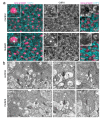Assembly of the outer retina in the absence of GABA synthesis in horizontal cells
- PMID: 20565821
- PMCID: PMC2919532
- DOI: 10.1186/1749-8104-5-15
Assembly of the outer retina in the absence of GABA synthesis in horizontal cells
Abstract
Background: The inhibitory neurotransmitter gamma-amino-butyric acid (GABA) not only modulates excitability in the mature nervous system but also regulates neuronal differentiation and circuit development. Horizontal cells, a subset of interneurons in the outer retina, are transiently GABAergic during the period of cone photoreceptor synaptogenesis. In rodents, both horizontal cells and cone axonal terminals express GABAA receptors. To explore the possibility that transient GABA expression in mouse neonatal horizontal cells influences the structural development of synaptic connectivity in the outer retina, we examined a mutant in which expression of GAD67, the major synthesizing enzyme for GABA, is selectively knocked out in the retina.
Results: Immunocytochemistry and electron microscopy revealed that the assembly of triad synapses involving cone axonal pedicles and the dendrites of horizontal and bipolar cells is unaffected in the mutant retina. Moreover, loss of GABA synthesis in the outer retina did not perturb the spatial distributions and cell densities of cones and horizontal cells. However, there were some structural alterations at the cellular level: the average size of horizontal cell dendritic clusters was larger in the mutant, and there was also a small but significant increase in cone photoreceptor pedicle area. Moreover, metabotropic glutamate receptor 6 (mGluR6) receptors on the dendrites of ON bipolar cells occupied a slightly larger proportion of the cone pedicle in the mutant.
Conclusions: Together, our analysis shows that transient GABA synthesis in horizontal cells is not critical for synapse assembly and axonal and dendritic lamination in the outer retina. However, pre- and postsynaptic structures are somewhat enlarged in the absence of GABA in the developing outer retina, providing for a modest increase in potential contact area between cone photoreceptors and their targets. These findings differ from previous results in which pharmacological blockade of GABAA receptors in the neonatal rabbit retina caused a reduction in cone numbers and led to a grossly disorganized outer retina.
Figures









Similar articles
-
Expression of connexin 35/36 in retinal horizontal and bipolar cells of carp.Neuroscience. 2009 Dec 15;164(3):1161-9. doi: 10.1016/j.neuroscience.2009.09.035. Epub 2009 Sep 22. Neuroscience. 2009. PMID: 19778581
-
Mammalian retinal horizontal cells are unconventional GABAergic neurons.J Neurochem. 2011 Feb;116(3):350-62. doi: 10.1111/j.1471-4159.2010.07114.x. Epub 2010 Dec 13. J Neurochem. 2011. PMID: 21091475
-
Immunocytochemical analysis of GABA-positive and calretinin-positive horizontal cells in the tiger salamander retina.J Comp Neurol. 2006 Nov 20;499(3):432-41. doi: 10.1002/cne.21116. J Comp Neurol. 2006. PMID: 16998928
-
GABA as a developmental neurotransmitter in the outer plexiform layer of the vertebrate retina.Perspect Dev Neurobiol. 1998;5(2-3):261-7. Perspect Dev Neurobiol. 1998. PMID: 9777641 Review.
-
The neuronal organization of the outer plexiform layer of the primate retina.Int Rev Cytol. 1984;86:285-320. doi: 10.1016/s0074-7696(08)60181-3. Int Rev Cytol. 1984. PMID: 6368448 Review.
Cited by
-
Developmental regulation and activity-dependent maintenance of GABAergic presynaptic inhibition onto rod bipolar cell axonal terminals.Neuron. 2013 Apr 10;78(1):124-37. doi: 10.1016/j.neuron.2013.01.037. Neuron. 2013. PMID: 23583111 Free PMC article.
-
Super-resolution STED imaging in the inner and outer whole-mount mouse retina.Front Ophthalmol (Lausanne). 2023 Apr 6;3:1126338. doi: 10.3389/fopht.2023.1126338. eCollection 2023. Front Ophthalmol (Lausanne). 2023. PMID: 38983015 Free PMC article.
-
Cell-specific cre recombinase expression allows selective ablation of glutamate receptors from mouse horizontal cells.PLoS One. 2013 Dec 12;8(12):e83076. doi: 10.1371/journal.pone.0083076. eCollection 2013. PLoS One. 2013. PMID: 24349437 Free PMC article.
-
Novel hybrid action of GABA mediates inhibitory feedback in the mammalian retina.PLoS Biol. 2019 Apr 1;17(4):e3000200. doi: 10.1371/journal.pbio.3000200. eCollection 2019 Apr. PLoS Biol. 2019. PMID: 30933967 Free PMC article.
-
Development and plasticity of outer retinal circuitry following genetic removal of horizontal cells.J Neurosci. 2013 Nov 6;33(45):17847-62. doi: 10.1523/JNEUROSCI.1373-13.2013. J Neurosci. 2013. PMID: 24198374 Free PMC article.
References
Publication types
MeSH terms
Substances
Grants and funding
LinkOut - more resources
Full Text Sources
Miscellaneous

